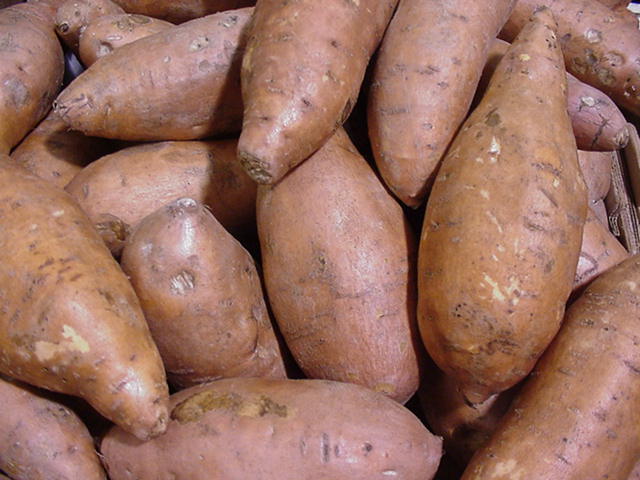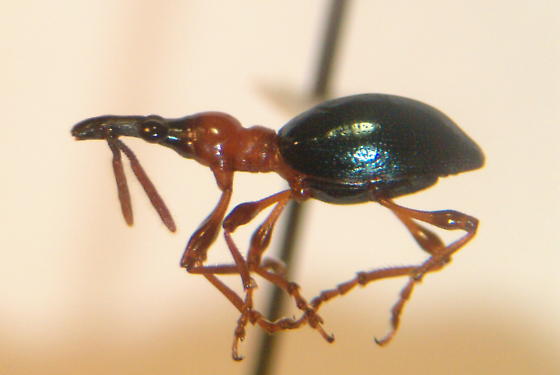|
Agriculture > Tuber Crops
> Sweet Potato (Ipomoea batatas)
|
|
|
|
About the Crop
|
|

Sweet potato or sakaravalli kizhangu (Ipomoea batatas) is a crop grown
for its sweet tasting starchy, tuberous roots rich in beta-carotene and anti oxidants.
The crop is an herbaceous perennial vine, bearing heart-shaped or lobed leaves and
medium-sized flowers. The edible tuberous root is long and tapered, with a smooth
skin whose color ranges between red, purple, brown and white, and flesh colour ranges
between white, yellow, orange, and purple.
It is native to the tropical parts of America and is now cultivated throughout tropical
and warm temperate regions. China is the leading producer accounting for more than
80 % of the world production. About two lakh hectares of land are under sweet potato
cultivation in India. The crop is cultivated mostly in Orissa, West Bengal, Bihar
and Uttar Pradesh.
|
|
Climate & Soil
|
|
|
|
Sweet potato requires a warm humid tropical climate with a mean temperature of about
22ºC. Though sensitive to frost, it can also be grown in the hills up to an altitude
of 1500-1800 m as a summer crop. Under rainfed conditions the crop requires a fairly
well distributed annual rainfall of 75-150 cm. Being a photosensitive crop, sunny
days and cool nights are favourable for better tuber development.
The crop can be grown on a variety of soils having good drainage, but grows best
in fertile sandy loam soils. Heavy clayey and very light sandy soils are not suitable
for proper tuber development.
Top
|
|
Varieties
|
|
|
|
Improved varieties: H-41-variety with
excellent cooking quality, sweet tubers, and duration of 120 days.
H-42 excellent cooking quality, with 120 days duration,
Sree Nandini, Sree Vardhini, Sree Rethna, Sree Bhadra, Kanjanghad, Sree Arun, Sree
Varun & Sree Kanaka
Sree Arun: A high yielding,
early maturing sweet potato with pink skin and cream flesh developed at the Central
Tuber Crops Research Institute (CTCRI), Sreekariyam. It is suited to the upland
and lowland conditions and it can be grown all through Kerala. Average yield is
20-28 t/ha.
Kanjanghad: KAU variety obtained through selection and duration of 105-120 days.
Sree Kanaka: Short duration
sweet potato with cream coloured skin and dark orange coloured flesh developed at
the CTCRI. Average yield is 10-15 t/ha.High carotene content (8.8-10 mg/100g). short duration: 75-85 days
Sree Varun: A high yielding,
early maturing variety with cream skin released from CTCRI. Average yield is 20-28
t/ha in 90-100 days.
Sree Bhadra: early maturing (90 days), trap crop for nematodes
Local varieties: Badrakali
Chuvala, Kottayam Chuvala, Chinavella, Chakaravalli, Anakomban
Sree Nandini: early maturing, drought tolerant variety with 100-105 days duration
and suited as such as cash crop in paddy fallows
Sree Vardhini: early maturing, carotene rich variety for food and feed with a duration of 100-105 days
Sree Rathna: early maturing, carotene rich orange fleshed variety with 90-105 days duration.
Top
|
|
Propagation & Planting
|
|
|
|
Season
Rainfed crop: June-July, September-October
Irrigated crops: October-November (for uplands) and January-February
(for low lands)
Preparation of land
Work the soil to a fine tilth by ploughing or digging to a depth of 15-25 cm. Make
ridges 25-35 cm high, 60 cm apart for planting vines.
Seeds and sowing
Sweet potato is propagated by means of vine cuttings. To obtain vine cutting, raise
nurseries from selected tubers using the following method. Eighty kg of medium sized
weevil free tubers (each of 125-150 g) are required for planting in the primary
nursery area (100 m2 to plant one hectare).
Plant the tubers at a spacing of 30-45 cm on ridges formed at 60 cm apart and replant
in secondary nursery of about 500 m2 area at a spacing of 25 cm. Apply
urea 15 days after planting at 1.5 kg / 100 m2 in the primary nursery.
To ensure better plant growth in the secondary nursery, 5 kg of urea has to be applied
in two split doses on 15th and 30th day after planting. Vines
obtained from the freshly harvested crop are also planted in similar nursery area
to obtain sufficient planting material. Cuttings obtained from the apical and near
apical portions of the vines are preferable for planting in the main field. Storing
of cut sweet potato vines with intact leaves, in bundles covered with banana leaves
(dipped in water) and kept under shade for two days prior to planting is recommended.
Irrigate the nursery every alternate day during the first 10 days and once in 10
days, thereafter. Vines will be ready for planting on the 45th day.
In the main field, plant vine cutting of 20-25 cm length on ridges 60 cm apart and
at a spacing of 15-20 cm between the vines. The cuttings can also be planted on
mounds taken at a spacing of 75 x 75 cm. On the top of each mound, 3-6 cuttings
can be planted. Plant the vine cuttings with the middle portion buried deep in the
soil and the two cut ends exposed to the surface. Ensure sufficient moisture in
the soil for early establishment of the cutting. Provide adequate drainage and prevent
water logging.
Top
|
|
Intercultural Operations
|
|
|
|
Manuring
Apply cattle manure or compost at 10 t/ha at the time of preparation of ridges.
The recommended N:P2O5:K2O dosage for sweet potato
is 75:50:75 kg/ha. For the reclaimed alluvial soils of Kuttanad, the recommendation
is 50:25:50 kg/ha. Apply N in two equal split doses, the first at the time of planting
and the second 4-5 weeks after planting. Apply full dose of P2O5
and K2O at the planting time.
Irrigation
When grown as irrigated crop, provide irrigation once in 2 days for a period of
10 days after planting and thereafter once in 7-10 days. Stop irrigation 3 weeks
before harvest. But one more irrigation may be given 2 days before harvest. IW /
CPE for higher tuber yield in non-rainy periods is 1:2 (approximate interval of
11 days). The application of N and K2O at the rate of 50 kg/ha is recommended
for the crop grown under irrigation.
Aftercultivation
Conduct two weeding and earthing up operations about 2 weeks and 5 weeks after planting.
The top dressing of fertilizers may be done along with the second aftercultivation.
Prevent development of small slender tubers at the nodes by turning the vines occasionally
during active growth phase.
Rotation and mixed cropping
Under irrigated conditions, sweet potato can be rotated with rice and planted during
December-January after harvest of the second crop of rice. As a mixed crop, it can
be grown along with colocasia, amorphophallus etc. Under rainfed conditions, green
manure crops such as kozhinjil and sunnhemp can be grown after harvest of the sweet
potato and later incorporated into the soil at the time of land preparation for
the succeeding crop.
Top
|
|
Plant protection
|
|
|
|
Sweet potato weevil (Cylas formicarius)
A serious pest of sweet potato that infest the crop in the field, in storage sheds,
and in propagation beds.The adults and larvae of the weevil damage the tuber by
feeding and making tunnels just under the skin.

Integrated control
1) Remove and destroy the crop residues of the previous crop.
2) Use healthy and weevil-free planting materials.
3) Apply Eupatorium odoratum leaves as mulch @ 3 t/ha at 30 DAP.
4) Trap adult weevils using sweet potato pieces (of about 6 cm diameter) of 100
g size, kept at 5 m apart during 50 to 80 DAP at 10 days interval. Tubers may be
cut and kept inside wire cages to avoid rat damage.
5) Use pheromone traps (3Z Dodecenyl 2E butenoate).
Top
|
|
Harvesting
|
|
|
|
The duration of the crop depends on the variety; but in general, the crop can be
harvested in about 3.5-4 months after planting. Harvest the crop when leaves begin
to turn yellow and the tubers mature. The maturity of tuber can be ascertained by
cutting fresh tubers. The cut surface will dry clear if the tuber is mature and
becomes dark green if immature. Harvest the crop by digging out the tubers without
causing injury. The average yield is 20-25 t/ha.
|
|